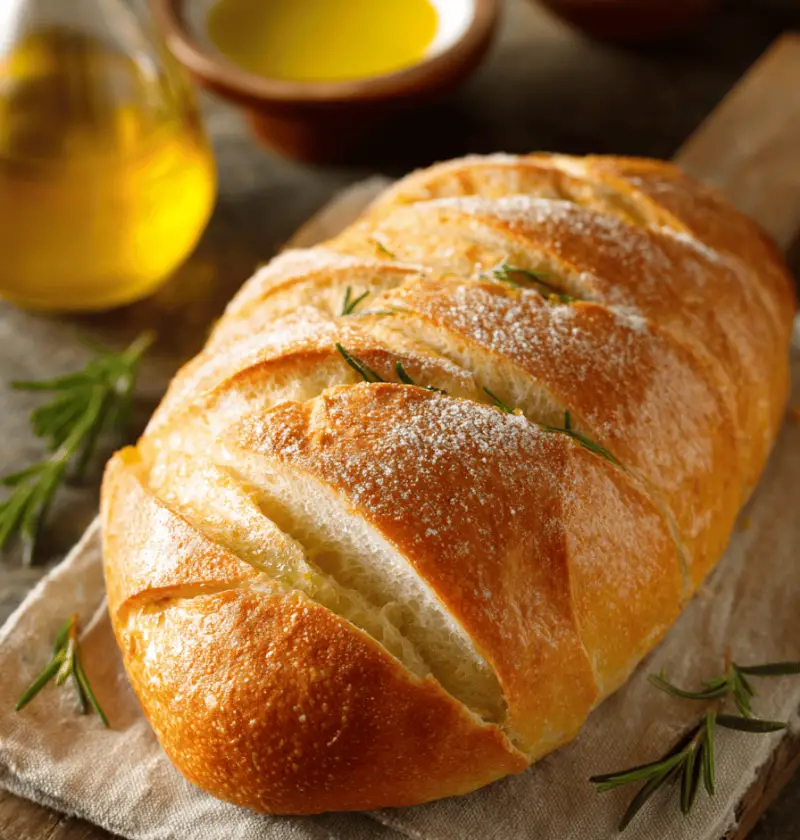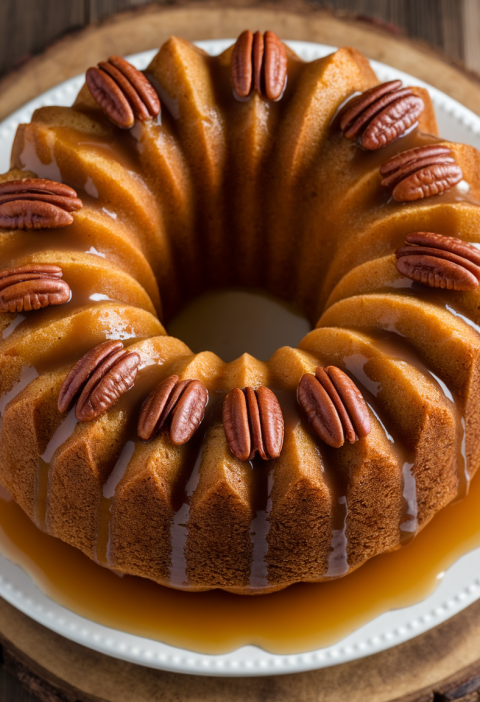Italian Bread Recipe
Crusty on the outside, fluffy on the inside—this classic Italian Bread Recipe brings a slice of Tuscany right to your kitchen.
Italian bread, with its golden crust and pillow-soft crumb, has been a family favorite for generations. Let me explain why this homemade artisan loaf feels special: we stick to traditional ingredients—flour, yeast, salt, and a drizzle of olive oil—but add a slow rise for extra depth of flavor. You know what? There’s something almost meditative about kneading dough until it springs back, then waiting as it doubles in size. I love serving it warm alongside minestrone on crisp autumn evenings or using thick slices for bruschetta at summer gatherings. Inspired by my Nonna’s Sunday routine, this recipe blends simplicity with that comforting “homemade” vibe.
Why You’ll Love This Recipe
– No fancy gadgets—just a bowl, a spoon, and your hands
– Pantry-friendly ingredients: yeast, flour, water, salt, olive oil
– Delightfully crusty edge with a light, airy interior
– Slow rise (about 2 hours) for richer taste and better chew
– Beginner-friendly steps with pro tips sprinkled throughout
– Yields two medium loaves—perfect for sharing (or freezing extras)
– Versatile for sandwiches, garlic toast, or dipping in herb oil
– Artisan look with minimal shaping skills required
Ingredients
– 4 cups (500 g) bread flour (substitute up to ½ cup whole wheat for nuttiness)
– 2 tsp (7 g) active dry yeast (or instant yeast—no proofing needed)
– 1½ tsp (9 g) fine sea salt (kosher works fine if you adjust volume)
– 1½ cups (360 ml) lukewarm water (105–110 °F helps yeast bloom)
– 2 Tbsp (30 ml) extra-virgin olive oil (adds tenderness)
– Optional: 1 tsp sugar or honey (feeds yeast, yields slight sweetness)
Tips:
• Flour: Unbleached gives the best flavor; add a tablespoon vital wheat gluten if you only have all-purpose.
• Yeast: Check expiration—if it doesn’t foam in water after 5 minutes, get fresh yeast.
• Salt: Mix it into the dry ingredients, not directly on yeast, to avoid slowing the rise.
Directions
1. Combine yeast and water.
In a large bowl, stir yeast (and sugar, if using) into lukewarm water. Let rest 5–7 minutes until bubbly—this foam shows your yeast is active.
-
Mix dry ingredients.
Whisk flour and salt together in a separate bowl to ensure even distribution and prevent salty spots. -
Form the dough.
Pour yeast water and olive oil into the flour mixture. Stir with a wooden spoon until dough forms, then switch to hands. -
Knead to smoothness.
Turn dough onto a lightly floured surface and knead for 8–10 minutes—look for a springy, tacky but not sticky texture. -
First rise.
Shape dough into a ball, coat lightly with oil, and transfer to a clean bowl. Cover with plastic wrap or damp cloth; let sit in a warm spot until doubled, about 1 hour. -
Shape your loaves.
Gently deflate dough and split into two pieces. Roll each into a tight oval or batard, tucking seams underneath. -
Final proof.
Place loaves seam-side down on a parchment-lined baking sheet. Cover loosely and let rest 30–45 minutes until puffy. -
Score and bake.
Preheat oven to 425 °F (220 °C). Right before baking, slash each loaf three times with a sharp blade. Bake 20–25 minutes until deep golden and crusty (internal temp about 200 °F). -
Cool before slicing.
Transfer loaves to a wire rack; let cool 15 minutes. This short wait gives you cleaner slices and sets the crumb.
Servings & Timing
– Yield: 2 medium loaves (about 12 slices each)
– Prep Time: 20 minutes (mixing & kneading)
– Rise Time: 1 hour first rise + 30–45 minutes proof
– Bake Time: 20–25 minutes
– Total Time: ~2 hours 15 minutes (plus cooling)
Variations
– Herb Infusion: Stir in 2 Tbsp chopped rosemary and 1 tsp garlic powder.
– Whole Wheat Twist: Replace 2 cups flour with whole wheat for heartier taste.
– Cheesy Top: Press ½ cup shredded Parmesan on loaves before baking.
– Seeded Crust: Brush with oil and roll in sesame, flax, or poppy seeds.
– Lemon-Rosemary: Add 1 Tbsp lemon zest + 1 Tbsp chopped rosemary to dough.
Storage & Reheating
Store loaves in a paper bag or wrapped in a clean towel at room temp—best eaten within 2 days. For longer life, slice and freeze in an airtight bag for up to 3 months. To refresh, wrap in foil and warm at 350 °F for 10 minutes, or toast slices lightly.
Make-Ahead Tip: After the first rise, refrigerate dough (covered) overnight. The next day, shape, proof, and bake for fresh morning loaves.
Notes
– A slightly damp towel over shaped loaves prevents a dry “skin” during proofing.
– If your kitchen is cool, heat a cup of water in the oven then turn it off—place dough inside for a warm proof environment.
– For extra-crisp crust, put a small pan of hot water on the oven floor while loaves bake.
– A ceramic baking stone deepens crust color, though a sheet pan works beautifully too.
FAQs
1. What flour is best for Italian bread?
Bread flour gives superior gluten structure, but all-purpose plus a bit of vital wheat gluten also delivers great results.
-
Can I use instant yeast?
Yes—mix it with the dry ingredients and skip the initial proofing step, though a quick water test never hurts. -
Why didn’t my dough rise?
Check yeast freshness and water temperature—too hot kills yeast, too cold slows the process. -
How do I achieve a really crusty crust?
Bake with steam: add a small pan of hot water to the oven or spritz loaves with water before closing the door. -
Can I freeze the raw dough?
Absolutely—after the first rise, wrap tightly and freeze up to one month; thaw overnight in the fridge before shaping. -
What hydration level works best?
Around 65% water to flour weight yields a soft interior without a dough too sticky to handle. -
How should I store leftover slices?
Keep at room temp in a sealed bag for immediate use or freeze for longer storage—toast to revive. -
Can I convert this to sourdough?
You can swap 1 cup active starter for yeast, reducing water and flour amounts accordingly and extending proof times.
Conclusion
This Italian Bread Recipe marries tradition with simplicity, delivering a crusty, fluffy loaf that’s perfect for any meal—from hearty sandwiches to elegant appetizers. Give it a try this weekend, and let me know how your kitchen smells afterward! Drop a comment below, share your photos on social media, or explore my Rustic Sourdough and Garlic Knot recipes next. Buon appetito!

Italian Bread Recipe
Ingredients
- 4 cups bread flour (substitute up to ½ cup whole wheat for nuttiness)
- 2 tsp active dry yeast (or instant yeast—no proofing needed)
- 1½ tsp fine sea salt (kosher works fine if you adjust volume)
- 1½ cups lukewarm water (105–110 °F helps yeast bloom)
- 2 tbsp extra-virgin olive oil (adds tenderness)
- 1 tsp sugar or honey (feeds yeast, yields slight sweetness)
Instructions
- In a large bowl, stir yeast (and sugar, if using) into lukewarm water. Let rest 5–7 minutes until bubbly—this foam shows your yeast is active.
- Whisk flour and salt together in a separate bowl to ensure even distribution and prevent salty spots.
- Pour yeast water and olive oil into the flour mixture. Stir with a wooden spoon until dough forms, then switch to hands.
- Turn dough onto a lightly floured surface and knead for 8–10 minutes—look for a springy, tacky but not sticky texture.
- Shape dough into a ball, coat lightly with oil, and transfer to a clean bowl. Cover with plastic wrap or damp cloth; let sit in a warm spot until doubled, about 1 hour.
- Gently deflate dough and split into two pieces. Roll each into a tight oval or batard, tucking seams underneath.
- Place loaves seam-side down on a parchment-lined baking sheet. Cover loosely and let rest 30–45 minutes until puffy.
- Preheat oven to 425 °F (220 °C). Right before baking, slash each loaf three times with a sharp blade. Bake 20–25 minutes until deep golden and crusty (internal temp about 200 °F).
- Transfer loaves to a wire rack; let cool 15 minutes. This short wait gives you cleaner slices and sets the crumb.







